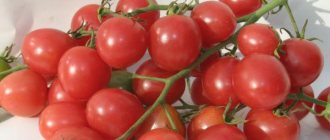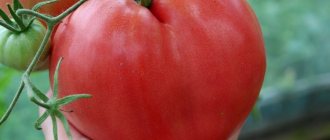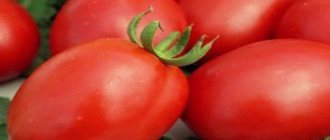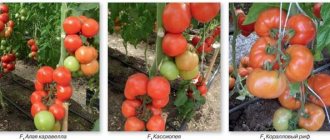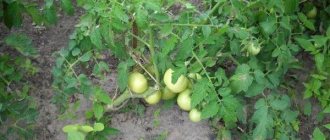The unusually named Everett's Rusted Heart tomato has an interesting color. Taste is rated top notch. In addition, gardeners love these tomatoes for their unpretentiousness and productivity.
| Height | Landing location | Ripening time | Fruit color | Fruit size | Origin | Fruit shape |
| Tall | Greenhouse, Open ground | Mid-season | Reds | Large | Variety | Heart-shaped |
Description and characteristics of the variety
Everett's Rusted Heart tomato is an indeterminate, tall variety.
Features of the bushes:
- height 1.8-2m;
- moderate foliage and branching;
- the number of fruiting clusters is 7-8.
Ripening time is average - 110-120 days from germination.
Fruit characteristics:
- average weight 250-400 g;
- color red-brown-burgundy;
- the skin is strong;
- the flesh when cut is pink-green, fleshy;
- the taste is sweetish with a gentle sourness.
Advantages and disadvantages of the variety
The first thing you remember about a tomato is its beautiful appearance, exquisite taste, and fruity aroma. Other qualities are also valuable.
- Productivity is high, especially in warm weather. Up to 10 kg are collected from the bush.
- The fruiting period is extended over time.
- Bushes do not take up much space in the beds.
- They do not require special fertilizers or repeated watering.
- Resistant to Fusarium wilt and blossom end rot.
- In the south, you can try planting these tomatoes in open ground.
The variety has disadvantages:
- Ripe tomatoes do not store well. It is recommended to eat or process them immediately after collection.
- Do not pick unripe, the taste of the tomato and aroma will not appear.
- The vegetable has a rough skin.
- Productivity depends on the weather. A warm summer is needed. The plant does not tolerate changes in daily temperature.
Attention! Heart-shaped tomatoes have thin stems and always need staking.
Features of cultivation and storage
Transplantation of seedlings is carried out in well-lit and fertilized areas. Compost, potassium sulfate and superphosphate are first added to the soil.
The holes are dug 30 cm deep. 3-4 bushes are placed per 1 m2. The optimal distance is 50 cm between plants.
Basic care details:
- regular fertilizing and watering;
- mulching with a layer of hay, straw, 8-10 cm thick;
- weed removal;
- formation into 1-2 shoots;
- stepsoning 1 time in 10 days.
For fertilizer, use a 1:10 diluted liquid solution of chicken manure or mullein. Phosphorus-potassium mixtures must be used. At the ripening stage, boric acid is used.
Ripe fruits are not stored for a long time - only 3-5 days and begin to leak.
About one of the most delicious and mysterious varieties of tomatoes - Everett's Rusted Heart
Everett's rusty heart. Another translation of “Everett’s Rusty Heart” is found in other sources. It's not entirely clear why it's rusty. The fruits, at least, are of normal color. Slightly different from the usual color of a tomato, but no more.
There are a lot of good reviews about this tomato. Even to the point of saying: “I don’t know any tastier tomatoes.” This alone is a reason to try planting these tomatoes on your site.
Description and characteristics
Today, the exact history of the origin of this variety and, in particular, its name, is practically unknown. However, the variety has the following characteristic features:
- The ripening period is mid-season.
- The bush can be called indeterminate, tall, up to 80 meters.
- It is advisable to form it into 1-2 stems, with obligatory tying and pinching.
- If we talk about the fruits, they are very unusual. First of all, in its color. They are green, with a burgundy-brown color, and a bronze tint. Their cut is green with a pink core. The following can be said about their shape: heart-shaped, with a blunt end. Or more rounded.
- The taste of the fruit is very sweet, with a harmonious, bright, fruity aroma.
- By weight they are 250-400 grams.
- The fruits are beautiful and neat. There are larger ones, there are smaller ones.
- The only thing is that they actually look like earrings. Correct shape.
- If we talk about the pulp, it is moderately juicy and meaty.
- If you like to consume fresh tomatoes, then you definitely need to plant this particular variety of tomatoes. It is rightfully considered one of the most delicious varieties for fresh consumption.
- For normal fruit ripening, good weather is needed. If the weather conditions are not favorable, the tomatoes will still grow. True, then there will be little fruit.
- We can say this is a mid-early tomato variety.
- Ripening time is approximately 110-120 days from the moment of first shoots.
- Nothing can happen without flaws, I guess. Some people say that the skin is a little rough, but this "flaw" is compensated many times over by the excellent taste of this variety.
- According to the gardeners, I didn’t remember anything unusual about the seedlings. Standard tomato.
- Unfortunately, the tomato does not stand at all. Literally a day - two at most, and it’s already starting to flow.
It is important not to overdo it. If the vegetable is overripe, it already takes on a brick tint. And overripening happens very quickly. Therefore, you need to be careful and keep a vigilant eye so as not to miss the normal state. It is more convenient to determine ripeness by touch - the fruit should still be hard, but already ripe. The softness should be felt by your fingers.
The disadvantages include the impossibility of storage, which has already been mentioned. Picking them when they are not ripe is also not an option. The taste, according to gardeners, is not the same.
Growing conditions
Where to grow this variety? In a greenhouse or maybe in the ground, i.e. in a regular garden bed? It is recommended to grow in a greenhouse. There are more opportunities to create the conditions the tomatoes need.
The variety is very productive. And if you cultivate it correctly at all stages, you can expect a good harvest. These are the following stages:
- Preparatory work during which the soil is sealed.
- Attentive attitude to the cultivation of plantings.
- Planting seedlings in the greenhouse soil.
- Treatment of tomatoes against numerous diseases and pests that threaten them.
- Developing a watering system that must be adhered to every day.
- We must not forget to feed the stems on time.
- We must also remember to pick the fruits on time and prevent them from overripening.
- Organization of fruit storage.
Violation of one or even several of the above (and below) rules will most likely reduce the entire opportunity to enjoy delicious fruits to a clear “no”.
- The first thing to do is prepare the seeds for planting. To do this, they should be doused with manganese for a quarter of an hour, then washed with plain water.
- Sowing should be carried out in containers (boxes, pots, or cassettes) to a depth of no more than 1 cm.
- After the plants have 2-3 leaves, they need to be picked.
- After this, they need to be planted with a large interval between the stems. You can - in separate pots.
- After the seedlings gain strength and strength, they need to be planted in the ground for further growth and harvest.
About diseases and pests
There is no data on this not entirely pleasant, but important topic specifically about this variety on the Russian-language Internet. Therefore, we will give a little information about the simple diseases and pests of this useful vegetable.
Let's start with the diseases:
- Internal browning of tomato fruits. The first signs that a plant is infected with this disease appear on green fruits. Browning occurs in the form of lumpy areas, compactions of a brownish-gray hue. As the fruit begins to ripen, it will result in uneven ripening. Plus, the lumpy areas retain their color. Or change it to yellow. If the fruit is cut, conductive tissues are visible on its walls.
- Stolbur. This is when large flowers have appeared, but they have not set fruit. If the infection occurred late, and some of the ovaries have already formed fruits, they have a yellowish color. But this is not because they suddenly become a different variety (it happens that uninfected fruits have a yellow color in some varieties), but in addition they become completely unsuitable for food.
- Late blight. This disease is rare in Everett Rustyheart tomatoes.” It is more typical for those tomatoes that grow in open ground. But this is one of the most common diseases. This is a fungal disease. Distributed everywhere. Brown spots appear on the stems and leaves, and a white coating can be seen on the inside of the leaves.
Unfortunately, these are not all the diseases that can befall tomatoes.
- Cotton (aka melon) aphid.
- Root-knot nematode.
- Colorado beetle.
- Nightshade miner.
- Rusty tomato mite.
- Cotton bollworm.
- Thrips.
Despite the fact that tomatoes have quite a lot of diseases and are attacked by many pests, they are still deservedly popular. Why? Because they are very tasty, they can be prepared in different dishes, and they are very, very healthy.
For a better understanding of what the Everett Rusty Heart variety is, you can look at the photographs below.
You can also watch a video that will tell you the main characteristics of the Everett Rusty Heart variety.
Dacha forum: dacha, garden, vegetable garden, flowers.
Dacha forum: about the dacha, about flowers, about your garden plot
Tomatoes 2019
Messages: 1984 Registered: 02.11.2010, 13:47 Interests: Reading, gardening. From: Bryansk region Sevsk Thanked: 2577 times Thanked: 1869 times
Status: Offline
Tomatoes 2019
Message from Marina_M » 01/05/2019, 14:31
Friends, I bought Diabolik and Nina tomatoes on the advice of an agronomist. Has anyone planted it? Please share how they taste?
Messages: 5694 Registered: 01/03/2012, 11:32 From: Moscow region. Thanked: 6671 times Thanked: 6096 times
Status: Offline
Tomatoes 2022 – 2
Posted by Aleksan9ra » 01/05/2019, 14:41
Messages: 1984 Registered: 02.11.2010, 13:47 Interests: Reading, gardening. From: Bryansk region Sevsk Thanked: 2577 times Thanked: 1869 times
Status: Offline
Tomatoes 2022 – 2
Message from Marina_M » 01/05/2019, 15:24
Messages: 2244 Registered: 02.26.2016, 17:48 Interests: Floristry Occupation: Vegetable gardening From: Moscow-Krasnoyarsk Thanked: 397 times Thanked: 974 times
Status: Offline
Tomatoes 2022 – 2
Message from Oladushka » 01/05/2019, 15:57
Messages: 35 Registered: 08/13/2018, 20:06 Interests: garden vegetable gardening floriculture cooking From: Kudymkar Thanked: 26 times Thanked: 4 times
Status: Offline
Tomatoes 2019
Message from babushkaka » 01/06/2019, 19:19
Messages: 53 Registered: 01/28/2016, 01:41 From: Moscow Thanked: 40 times Thanked: 14 times
Status: Offline
Tomatoes 2019
Message from Lyubov1979 » 01/08/2019, 11:33
Friends, I bought Diabolik and Nina tomatoes on the advice of an agronomist. Has anyone planted it? Please share how they taste?
Messages: 53 Registered: 01/28/2016, 01:41 From: Moscow Thanked: 40 times Thanked: 14 times
Status: Offline
Tomatoes 2019
Message from Lyubov1979 » 01/08/2019, 12:16
Messages: 2244 Registered: 02.26.2016, 17:48 Interests: Floristry Occupation: Vegetable gardening From: Moscow-Krasnoyarsk Thanked: 397 times Thanked: 974 times
Status: Offline
Tomatoes 2019
Message from Oladushka » 01/10/2019, 12:56
Growing conditions
Where to grow this variety? In a greenhouse or maybe in the ground, i.e. in a regular garden bed? It is recommended to grow in a greenhouse. There are more opportunities to create the conditions the tomatoes need.
The variety is very productive. And if you cultivate it correctly at all stages, you can expect a good harvest. These are the following stages:
- Preparatory work during which the soil is sealed.
- Attentive attitude to the cultivation of plantings.
- Planting seedlings in the greenhouse soil.
- Treatment of tomatoes against numerous diseases and pests that threaten them.
- Developing a watering system that must be adhered to every day.
- We must not forget to feed the stems on time.
- We must also remember to pick the fruits on time and prevent them from overripening.
- Organization of fruit storage.
Violation of one or even several of the above (and below) rules will most likely reduce the entire opportunity to enjoy delicious fruits to a clear “no”.
- The first thing to do is prepare the seeds for planting. To do this, they should be doused with manganese for a quarter of an hour, then washed with plain water.
- Sowing should be carried out in containers (boxes, pots, or cassettes) to a depth of no more than 1 cm.
- After the plants have 2-3 leaves, they need to be picked.
- After this, they need to be planted with a large interval between the stems. You can - in separate pots.
- After the seedlings gain strength and strength, they need to be planted in the ground for further growth and harvest.
Read also: Egg with boric acid from ants recipe
Tomato Belfort
Mid-season, productive, cluster hybrid. In the middle zone, we recommend growing it in a greenhouse.
Bush of indeterminate type, up to 2.5 meters high in closed ground. The plant is characterized by short internodes. The first inflorescence is formed above the 9th leaf, then every 2 leaves. The clusters are simple, with 5-7 fruits each.
Requires pinching and tying to the trellis. We recommend forming it into 1 stem, removing all the stepsons.
Basic qualities of fruits
Tomatoes are dense, smooth, round in shape with a pointed nose. The average fruit weight is 250-300 grams. When fully ripe, they are rich red in color and have an excellent (for a hybrid) tomato taste. These tomatoes are suitable for fresh consumption and home cooking.
Advantages and disadvantages
The hybrid is resistant to tomato mosaic virus, cladosporiosis, verticillium and fusarium.
The fruits have a marketable appearance and excellent transportability, and are in demand on the market.
The only disadvantage is that this is not a variety - you cannot take seeds. Well, the taste is inferior to varietal tomatoes, although among the hybrids it stands out in the “tasty” direction.
Features of cultivation, planting and care
We recommend sowing the seeds of this tomato for seedlings 60-65 days before the intended planting in the ground. When planting seedlings in a greenhouse, place on 1 sq. meter up to 4 plants. We recommend adding 0.5 cups of ash, 1 tablespoon each of superphosphate and potassium sulfate, as well as 1 tbsp to the prepared hole for planting tomatoes. a spoonful of fishmeal (mix with soil). Water the hole well and only then plant the plants.
Further care of the plants consists of timely watering (in hot weather 3 times a week, in normal weather 1-2 times), fertilizing with complex mineral fertilizer, pinching and preventive measures to protect against diseases and pests.
Belfort tomatoes on video
Growing experience in Astrakhan. From picking to harvesting.
If you grew Belfort tomatoes, please write whether you liked them or not. What was the yield and taste of the fruits like under your climatic conditions? How do you rate the disease resistance of this variety? Briefly describe the advantages and disadvantages of this tomato in your opinion. If possible, attach a photo of your tomatoes to your comment. Thank you!
Your reviews of the Belfort tomato and additions to the description will help many gardeners evaluate this variety more objectively and decide whether it is worth planting or not.
Characteristics of the tomato Burning Heart and technique for growing the variety
The Flaming Heart tomato is included in the State Register of Breeding Achievements and is intended for cultivation under temporary film covers and in open ground. The heart-shaped, raspberry-colored fruits have a sweet taste and fleshy pulp.
Advantages of the variety
Altai breeders gave gardeners a pink tomato called Flaming Heart, which bears fruit abundantly in cold climates. The variety is designed for cultivation in open ground and under temporary shelters.
During the growing season, the height of the indeterminate bush reaches 180 cm and requires tying to a support. Plants with a medium number of leaves of an intense green color. The average period of harvest ripening from the moment sprouts appear is 100 days.
On the main stem, 6 clusters with simple inflorescences are formed. During the fruiting period the bush has an attractive appearance. Raspberry-colored hearts look elegant among the foliage.
The description of the variety is associated with the characteristics of heart-shaped fruits with a sweet taste, juicy pulp, and dense skin. Near the stalk there is a slight ribbing. The unripe fruit is light green in color without a spot. At the ripe stage, the tomato acquires a crimson color.
The characteristics of the variety indicate high productivity and excellent taste. The weight of a tomato reaches 195-280 g. Forming a bush into 2 stems allows you to grow fruits weighing 360-500 g.
With a horizontal cut, the presence of 6 chambers with seeds or more is observed. Compliance with the rules of growing crops allows you to remove 6.4 kg of vegetables from 1 m².
In cooking, the Flaming Heart tomato is used for preparing salads, juices, and canning. During the ripening period, the fruits are often prepared as a fire platter, which is tasty and healthy due to the content of lycopene, ascorbic acid, and sugar.
Reviews from vegetable growers cultivating the Flaming Heart variety indicate resistance to the main types of diseases of nightshade crops. They indicate the ability to transport fruits over distances. The plant is affected by septoria and alternaria at the standard level.
Agricultural cultivation technology
Growing tomato has its own characteristics, so the correct application of the recommendations of experienced vegetable growers can ensure high crop yields. Seeds for planting from well-known manufacturers can be planted without pre-treatment with growth stimulants.
Material collected from the previous harvest must be tested for germination. To do this, the seeds are placed in an aqueous solution of table salt and the weak grains are removed. After treatment with a solution of aloe juice, they are placed in a container with compacted soil.
A layer of peat, 1 cm thick, is poured on top. Seedlings begin to be grown 50-60 days before the expected date of planting in the ground. In the phase of formation of 2 true leaves, picking is carried out in separate pots.
For the normal development of seedlings, compliance with the thermal and light conditions is required. Additional lighting is created using fluorescent lamps, extending the day to 16 hours a day.
During the period of growing seedlings, soil moisture is regularly monitored and fertilizing is applied with complex fertilizers according to the manufacturer’s scheme.
7-10 days before planting in a permanent place, seedlings are hardened off. The soil for tomatoes is prepared in the fall: it is plowed and composted. In the spring, before planting, a complex of mineral fertilizers containing potassium and phosphorus is applied.
Bushes need moderate watering. To evenly distribute moisture near the root system, the soil is mulched using straw and leaves. Mulch stops the growth of weeds and serves as a source of additional organic nutrition for plants.
It is recommended to remove the fruits from the bush as they ripen so that the plant can give strength to the ripening tomatoes.
Rules of care
Caring for it is simply necessary. It starts from the very beginning of planting seeds until harvesting. To collect good tomato fruits, you need to work hard. To do this, it is recommended to water the tomatoes in a timely manner, carry out weeding, loosening the soil, as well as systematically apply fertilizers and fight diseases and pests.
Orange tomatoes need to be watered as the soil dries out.
You should also pay attention to weather conditions. If there are frequent and heavy rains, the seedlings are not watered, and in case of drought, watering can be carried out up to 2 times a day
Immediately after transplanting a tomato, it should not be watered for several days. This will help avoid blackleg, rot and other diseases. Afterwards water as usual. And more abundant watering should be carried out during the flowering of the bushes and the setting of fruits.
Weed and loosen the soil as needed, usually every 1.5-2 weeks.
Fertilizing is applied about 3 times during the entire growth of the tomato. First, fertilizer is applied 14 days after transplanting the seedlings, then during the flowering period and the last fertilizing is applied when the fruits begin to form. Mineral and organic compounds can act as fertilizers.
When using them, be sure to follow the instructions and apply fertilizer only in clear, warm weather.
Also, during the growth and development of Orange tomatoes, the bushes should be chopped and tied up. For this purpose, the most powerful and developed stems are left; those without ovaries are removed, as are excess leaves. This is necessary for the tomato fruit to grow well. If you do not chop the bushes in a timely manner, all the nutrients and energy of the plant will be spent only on the growth of greenery.
Features of care
Caring for the variety includes the following mandatory activities:
- Timely watering with warm water (better after sunset).
- Weed removal.
- Periodic loosening of the soil.
- Treatment with high-quality mineral fertilizers.
Description of the tomato variety Yasha Yugoslavsky, features of plant care
This tomato variety has its own history. He gained fame in the USA, but he came to the country from Yugoslavia. Recommended for growing in a greenhouse in cool countries, and in the ground in warm countries. Its peculiarity is that the Yasha Yugoslav tomato has a powerful, tall bush. For this reason, for good fruit development, it should be tied to a support. He also needs stepsoning.
The only drawback is the tendency for flowers to become terry. This leads to the fact that the fetus can double, and sometimes even build. This phenomenon is bad because the appearance deteriorates, the taste deteriorates and the skin thickens. The plant spends a lot of effort on their formation, which has a bad effect on the rest of the harvest. Often this negative phenomenon is attributed to improper care. In order for the fruits to be the same, you should follow the watering regime and promptly remove the terry buds that appear.
It is better to form the plant into bushes of two stems. They will be easy to care for and convenient to harvest.
